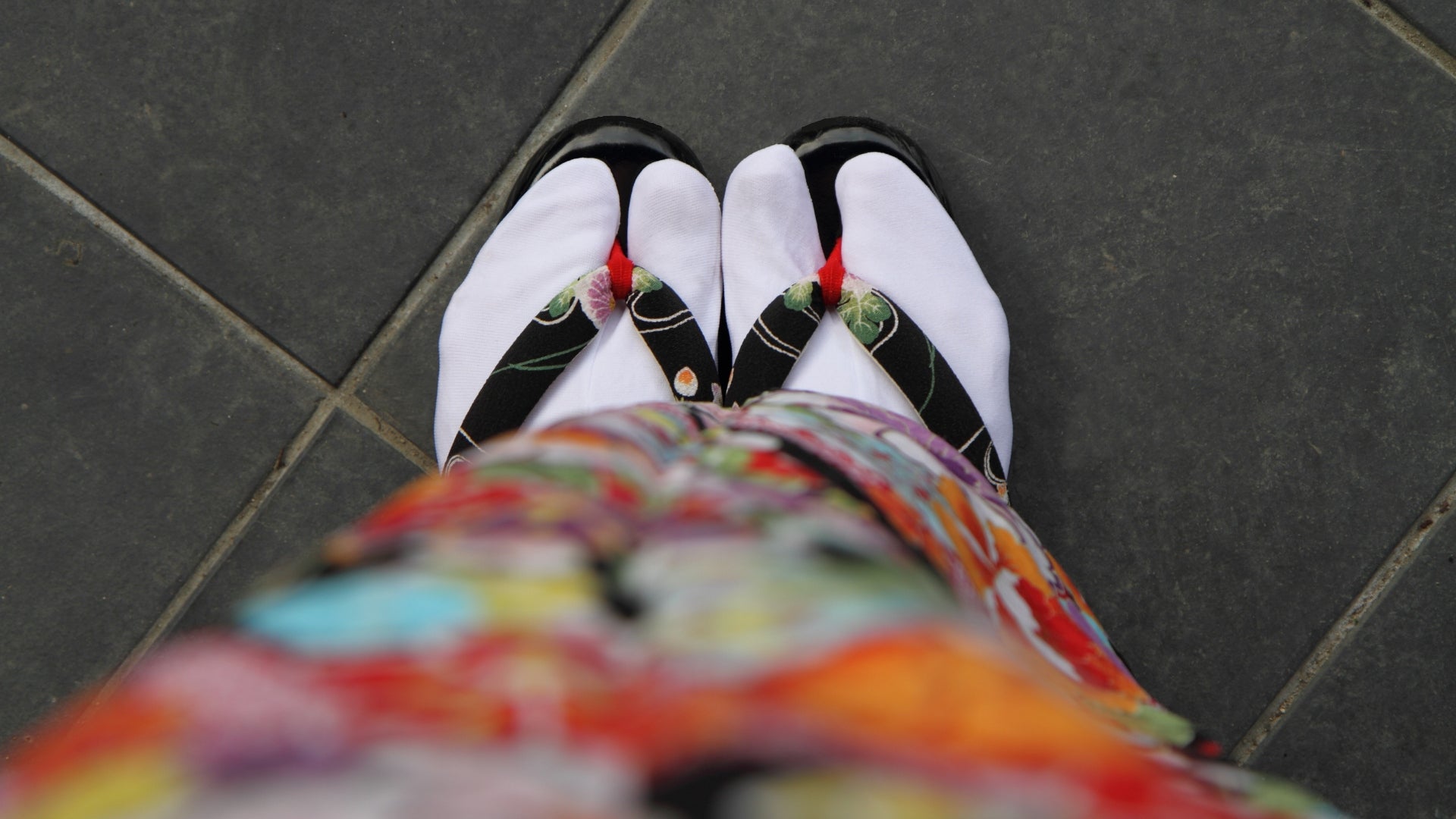
Geta (下駄): History of Traditional Japanese Sandals
Geta Japanese sandals, also known as traditional Japanese wooden footwear, resemble both clogs and flip-flops. Let's find out everything about this icon of the Japanese culture!

Perfection Flickr photo by Raita Futo
- What are Geta Japanese sandals?
- History of Geta
- How to properly wear Geta sandals?
- What are the advantages of wearing Geta?
- Are Geta shoes comfortable to wear?
- Geta and Zori
- A traditional Geta shop: Tsujiya
- How to Make Geta sandals
What are Geta Japanese sandals?
They weren't originally designed for fashion, instead, they had a practical purpose: they needed to keep the kimono above the ground, to avoid it
from getting dirty because of the mud or the snow.
For example, the merchants of sushi wore them, to keep some kind of distance from the scraps of fish on the floor.
Another reason why Geta were invented, was to solve the problem of always taking the shoes off and on when entering someone's house: these sandals were more practical than footwear with shoelaces.
History of Geta

According to historians, it is likely that geta originated from Southern China, and were later exported to Japan, they were created between the Ming (1368-1644) and Qing dynasties (1644-1912).
Geta sandals, however, couldn't be worn by anyone.
During the feudal period in Japan, Oiran (花魁), high-ranking courtesans, wore them.
Their geta were called "Koma-geta": tall and lacquered sandals with an elevated wooden base held on to the foot with a finger-width piece of fabric, called the tooth.
Oiran used to wear this kind of shoe, styled with kimonos or yukata (unlined cotton summer kimono), on specific occasions, such as walking in parades with their attendants.
They choose not to wear tabi, traditional Japanese socks along with geta, while geishas and maikos (apprentice geishas) had to always wear them.
How to properly wear Geta sandals?
The only way to wear them is this one: the toes have to pinch the strap to lift the heel of the geta base because wearing them otherwise would make it difficult to balance the weight of the body.
They aren't hard to wear, but balance is key and it takes some practice to get used to it, for sure.
There are some factors which need to be considered: they need to be the right size, these shoes need to be worn quite small, precisely one or two centimeters smaller than the actual size of your feet and some of the heel needs to hang off the back of the sandal, to be considered a perfect fit.
As I wrote before, the traditional way to style geta is to pair them with a kimono or a yukata: the summer kimono.
This means that during warm summer months geta can also be worn without socks for local festivals, as long as they're paired with yukatas which are more informal compared to traditional kimonos.
What are the advantages of wearing Geta?
Geta protect your feet from many different things, such as the dirt that's on the streets.
The high teeth will help you keep your clothes far from the ground, this way they won't get damaged and they'll remain clean for a longer time.
Another great advantage you can get, by wearing geta, is that they provide freedom to your feet.
This way, they won't be locked inside closed-toe footwear like sneakers and your feet will thank you for not being squeezed against the sole throughout all day.
There's one more advantage you need to consider if you wanna buy these Japanese wooden sandals, and that is they'll help you hold and preserve a good posture: it will be easier to stand up straight!
Lastly, according to Japanese people, geta will also stimulate the acupuncture points of your feet, while wearing them.
Are Geta shoes comfortable to wear?
It depends on what type of geta you get, there are many styles and some are more comfortable than others.
You won't experience discomfort, because these shoes offer ankle support and also a good grip, lastly, the prices can be quite reasonable, but some of them, especially customized ones, will be expensive.
Geta and Zori
Nowadays, different styles of geta can be found and some of them have a modern twist, according to XXI century fashion.
We've already described the Japanese geta shoes and now we're going to learn some things about another version of geta: zori sandals.
First of all, geta have more of a square shape, while zori have a rounder shape, an interesting fact is that women's zori always have a heel and they're decorated with different fabrics.
For example, at weddings women wear elegant kimonos along with prestigious brocade fabric-covered zori.
On the other hand, men's ones are flat and have a more casual style, they can also be worn barefoot, which means you don't need tabi: toe socks (with divided toes).
These typical socks are always required for women on every occasion unless it's a casual one and they are predominantly white.

A traditional Geta shop: Tsujiya
One of the most ancient traditional geta shops in Japan, it's situated in the city of Asakusa, the Taito district (Tokyo). Tsujiya is a 100-years-old footwear store, that specializes in making geta and zori.
They are handmade by local artisans, who have inherited this shop generation after generation.
This shop preserves tradition while taking it to the next level, here you can get your customized pair of geta.
Tsujiya was founded in 1912 by Tsuji Minokichi and if you visit the store, you will find the fourth generation of the family running the business.
The shop has now evolved, they also created a website along with an online shop, which makes it easier for everyone to buy their sandals.
The artisans who make these wooden sandals have over 50 years of experience in this area of competence and are currently teaching to younger apprentices too, to keep this tradition and handcraft culture alive.
How to make Geta sandals
Making geta is a long process, which requires mainly manual skills. There are two primary ways of making them: the first method consists in using just one piece of wood, while for the second one you glue three pieces of wood together.
The real technique is considered to be the first one, in which you use only one piece of wood, of your choice.
Did you know that not only a skilled craftsman can make them?
Nowadays, there are tutorials for anything, you can try to make your handmade geta, by following one of them.
They can be easily found online or you can also watch videos on Youtube.
It can be challenging trying to make geta by yourself because you'll surely need some professional woodworking tools.
The first step is selecting which type of wood you'd like to use for your pair of geta, that's an important choice because you don't want your wood to be full of cracks or holes.
Once you've chosen it, it's now time to cut out two thick pieces in a rectangular shape.
The next step is to sand down the rough surface of the wood with sandpaper, this process can take quite some time, especially if you're a perfectionist.
At this point, the teeth of geta need to be carved out, this phase will take a lot of time (carefully use a chisel and a hammer to do this).
Next, take a quite large file and start sanding the bottom of the sandals.
Then, start to round the edges, put some tree oil on your geta, and after that, it's time to strengthen the teeth by drilling two holes and filling them with some proper glue.
Once it's dried, make the holes for the laces (Hanao).
Your geta are almost done, the last thing to do is put a strong fabric (for example wool) through the holes previously made and sew them according to your feet size.
A useful tip is to put rubber soles on the teeth to prevent them from getting damaged, this also helps lower the noise they make when walking in them.
In conclusion, there's no reason why you shouldn't get yourself a pair of these eye-catching sandals, even if presently they're not worn that often except for formal occasions.
It's a fact: these Japanese sandals are a statement piece to add to your shoe collection!
Whether you're planning a trip to Japan, you're gonna blend into Japanese culture even more by wearing geta or zori and a kimono, it only takes some practice to rock them as locals do!



